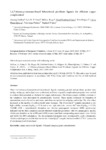1,4,7‐triazacyclononane‐based bifunctional picolinate ligands for efficient copper complexation

Use este enlace para citar
http://hdl.handle.net/2183/21416Coleccións
- GI-REACT! - Artigos [119]
Metadatos
Mostrar o rexistro completo do ítemTítulo
1,4,7‐triazacyclononane‐based bifunctional picolinate ligands for efficient copper complexationAutor(es)
Data
2017-05-10Cita bibliográfica
Guillou, A., Lima, L. M., Roger, M., Esteban‐Gómez, D., Delgado, R., Platas‐Iglesias, C., Patinec, V. and Tripier, R. (2017), 1,4,7‐Triazacyclononane‐Based Bifunctional Picolinate Ligands for Efficient Copper Complexation. Eur. J. Inorg. Chem., 2017: 2435–2443.
Resumo
[Abstract] Three 1,4,7‐triazacyclononane‐based (tacn‐based) ligands containing picolyl and picolinate pendant arms (no3py, no2pa1py, and no3pa) were synthesized, and their copper(II) complexation properties were studied to evaluate their potentials as chelators for copper radioisotopes. The thermodynamic stability constants of the complexes were determined by potentiometric titrations. These studies evidenced the formation of mononuclear species for no3py and mono‐ and dinuclear species for no2pa1py and no3pa. The pCu values decreased as the number of carboxypicolyl arms increased. The [Cu(no3py)]2+ complex presented a very high stability constant (log KCuL = 27.4) and a very high selectivity towards Zn2+ ions (log KZnL = 17.25). Vis/NIR (NIR = near‐infrared) absorption and electron paramagnetic resonance (EPR) spectroscopy indicated that the three complexes present distorted octahedral geometries with two paramagnetic species, which were identified as the Δ(δδδ) and Λ(δδδ) isomers [and their corresponding enantiomeric forms Λ(λλλ) and Δ(λλλ)] by DFT calculations. The electrochemical properties were investigated by cyclic voltammetry, which revealed quasireversible behavior for the [Cu(no3py)]2+ complex but irreversible Cu2+/Cu+ systems for [Cu(no2pa1py)] and [Cu(no3pa)]–.
Palabras chave
Copper
Macrocyclic ligands
N ligands
Imaging agents
Potentiometry
Macrocyclic ligands
N ligands
Imaging agents
Potentiometry
Versión do editor
Dereitos
This is the peer reviewed version of the following article: Guillou, A., Lima, L. M., Roger, M., Esteban‐Gómez, D., Delgado, R., Platas‐Iglesias, C., Patinec, V. and Tripier, R. (2017), 1,4,7‐Triazacyclononane‐Based Bifunctional Picolinate Ligands for Efficient Copper Complexation. Eur. J. Inorg. Chem., 2017: 2435–2443, which has been published in final form at https://doi.org/10.1002/ejic.201700176. This article may be used for non-commercial purposes in accordance with Wiley Terms and Conditions for Use of Self-Archived Versions.
ISSN
1434-1948
1099-0682
1099-0682





